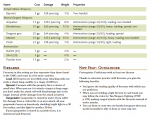Celebrim
Legend
Doesn't matter how large combats are, for the type of combat you want you are several centuries too late when you use Napoleon as example.
That's at least partially true. By the time you get to the Napoleonic Wars, melee weapons are basically obsolete as weapons of war and Kobold Avenger's vision of how wars in that era played out is actually as you say a century or two too late. The thing is though, it would take a bit over 100 years before everyone would really realize that and adjust tactics accordingly, and many of the commanders in that period did believe - sometimes against the evidence of their senses - that battles were fought in the way Kobold Avenger described.
And on the other other hand, the usual conditions that the PC's are expected to fight in is nothing like warfare.
My advice to @[Kobold Avenger] if he wants more shock and charge tactics to prevail would be to limit firearms technology to matchlocks and maybe wheellocks. By the time you get to Flintlocks the days of the melee weapons are largely behind you, and certainly by the time you get to the rifled mini-ball they are past.

